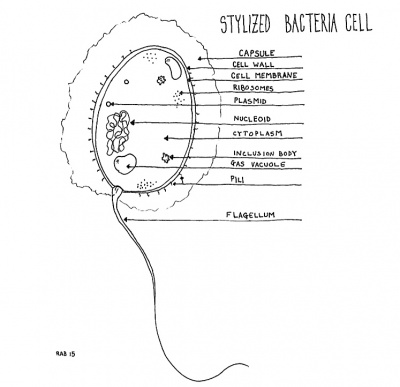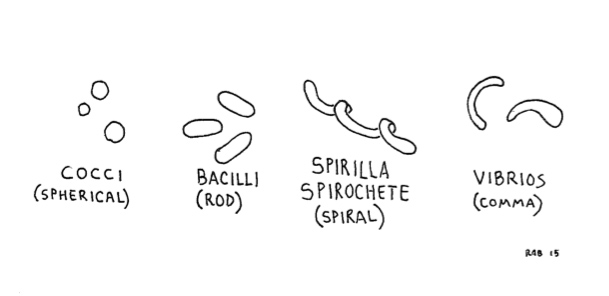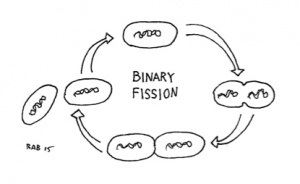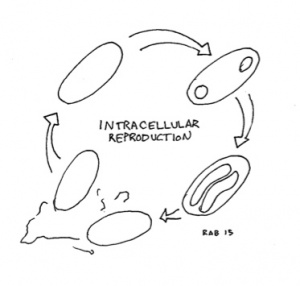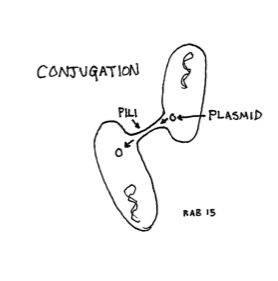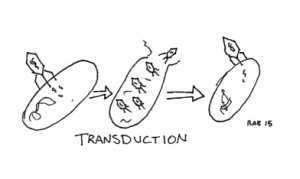Difference between revisions of "AY Honors/Bacteria/Answer Key"
| Line 67: | Line 67: | ||
==5. Explain the different forms of reproduction of bacteria. What are the main environmental conditions necessary for bacteria to reproduce?== <!--T:6--> | ==5. Explain the different forms of reproduction of bacteria. What are the main environmental conditions necessary for bacteria to reproduce?== <!--T:6--> | ||
| + | |||
| + | Different types of bacteria have different environmental requirements for reproduction, but in general bacteria usually need warm locations with plenty of their particular nutrients readily available. | ||
| + | |||
| + | Most bacteria reproduce through binary fusion, a form of asexual reproduction. In this process, the bacteria creates a duplicate set of genetic material, the genetic material moves to each end of the bacteria, and the cell then squeezes in half, creating two effectively identical bacteria cells. | ||
| + | |||
| + | [[Image:Binary.jpg|300px]] | ||
| + | |||
| + | There are also a few variations of asexual reproduction in different groups of bacteria. | ||
| + | |||
| + | Some Cyanobacteria produce Baeocytes, enlarged bacterial cells that have rapid multiple division internally before breaking open and spewing out numerous new bacteria. | ||
| + | |||
| + | [[Image:Baeocyte.jpg|300px]] | ||
| + | |||
| + | Certain bacteria may reproduce through budding, a process where a small bud forms on a parent bacteria, genetic material is transferred to the bud, and then it separates. | ||
| + | |||
| + | [[Image:Budding.jpg|300px]] | ||
| + | |||
| + | Some bacteria, including some of the Firmicutes bacteria, create two complete daughter cells inside the parent, then the parent breaks open and dies, releasing the two new bacteria cells. | ||
| + | |||
| + | [[Image:Intracellular.jpg|300px]] | ||
| + | |||
| + | Given that bacterial reproduction is primarily through forms of fission (division), there is no change in genetic material aside from mutation. However, Bacteria do have other ways to transfer genetic material, though not quite analogous to sexual reproduction. | ||
| + | |||
| + | Conjugation: Bacteria transfer genes (usually on plasmids) via their pili. | ||
| + | |||
| + | [[Image:ConjugationSketch.jpg|300px]] | ||
| + | |||
| + | Transduction: A bacteriophage (a virus that uses bacteria as a host) may pick up some pieces of genetic material from a previous host and incidentally transfer it into a new bacterial host. | ||
| + | |||
| + | [[Image:Transduction.jpg|300px]] | ||
| + | |||
| + | Transformation: Bacteria may pick up fragments of genetic material from their environment, usually left by dead bacteria. | ||
| + | |||
| + | [[Image:TransformationBacteria.jpg|300px]] | ||
==6. What do bacteria feed on and how to they breathe?== <!--T:7--> | ==6. What do bacteria feed on and how to they breathe?== <!--T:7--> | ||
Revision as of 03:27, 28 March 2015
Bacteria
Approval authority:
Category:
Skill Level:
Year of Introduction:
![]()
Contents
1. What are the main characteristics of bacteria that distinguish them from other living beings?
Bacteria are single cell organisms (though some do form chains or other colonial groupings, each individual remains its own organism).
The have no membrane around their internal organelles - so rather than a nucleus containing genetic material, which has its own membrane keeping it separate from the rest of the cell contents, bacteria have a nucleoid, without a distinct membrane.
All but one group of bacteria have both a cell membrane and a cell wall.
The genetic material in a Bacteria is in a tangled loop in the nucleoid
Many bacteria also have loops of genetic material, called Plasmids, that can serve to transfer genetic information between organisms, and may provide new or useful characteristics for a bacteria, which in part explains why they are able to adapt so quickly as species.
2. Through drawings or pictures, identify the main structures of the bacterial cell.
Some structures of bacteria
Capsule (Slime Layer): Provides protection, as well as may serve for adhesion (sticking the cell to something)
Cell Wall: Provides form, structure and protection. There are two different basic structures of cell walls in Bacteria. One is a cell wall made of a relatively thick layer of Peptidoglycan (carbohydrates and proteins). The other has an additional outer layer that includes carbohydrates, proteins and lipids (fats).
Cell Membrane: The boundary of the cell, selectively permeable to allow certain molecules and gasses to pass through.
Ribosome: The organelle responsible for protein synthesis
Plasmid: A ring of genetic material separate from that within the nucleoid
Nucleoid: The location of the genetic material of a bacteria
Cytoplasm: The “goo” inside the cell, in which the organelles and all other content exist.
Inclusion Body: Non-membranous granules in the cytoplasm used to store materials
Gas Vacuole: In some water-borne bacteria, small gas filled pockets used for bouyancy
Pili: microscopic tubes on some bacteria, used for attachment, or as a way to connect two bacteria to transfer genetic material
Flagellum: A hair- or whip-like appendage, used for motility
Endospore: A hard-cased spore produced by a bacteria often to assist in survival of hostile environment.
3. Draw the four main forms of bacteria.
Two main types are Cocci (roughly spherical) and Bacilli (rod-shaped).
Other forms include the comma-shaped Vibrios, and two types of corkscrew-shaped bacteria, the rigid Spirilla and the flexible Spirochetes.
4. What are gram negative and gram positive bacteria?
As noted above, bacteria have two types of cell walls. One is a cell wall made of a relatively thick layer of Peptidoglycan (carbohydrates and proteins). The other has an additional outer layer that includes carbohydrates, proteins and lipids (fats). Hans Christian Joachim Gram, a Danish bacteriologist, developed a staining method to rapidly identify which of these two basic cell walls a bacteria possesses. The bacteria with the first type of cell wall are stained using Gram’s method, those of the second type are not stained. Thus the former are referred to as Gram Positive bacteria, the latter Gram Negative. The Gram test is often one of the first performed to help identify a particular bacteria colony.
5. Explain the different forms of reproduction of bacteria. What are the main environmental conditions necessary for bacteria to reproduce?
Different types of bacteria have different environmental requirements for reproduction, but in general bacteria usually need warm locations with plenty of their particular nutrients readily available.
Most bacteria reproduce through binary fusion, a form of asexual reproduction. In this process, the bacteria creates a duplicate set of genetic material, the genetic material moves to each end of the bacteria, and the cell then squeezes in half, creating two effectively identical bacteria cells.
There are also a few variations of asexual reproduction in different groups of bacteria.
Some Cyanobacteria produce Baeocytes, enlarged bacterial cells that have rapid multiple division internally before breaking open and spewing out numerous new bacteria.
Certain bacteria may reproduce through budding, a process where a small bud forms on a parent bacteria, genetic material is transferred to the bud, and then it separates.
Some bacteria, including some of the Firmicutes bacteria, create two complete daughter cells inside the parent, then the parent breaks open and dies, releasing the two new bacteria cells.
Given that bacterial reproduction is primarily through forms of fission (division), there is no change in genetic material aside from mutation. However, Bacteria do have other ways to transfer genetic material, though not quite analogous to sexual reproduction.
Conjugation: Bacteria transfer genes (usually on plasmids) via their pili.
Transduction: A bacteriophage (a virus that uses bacteria as a host) may pick up some pieces of genetic material from a previous host and incidentally transfer it into a new bacterial host.
Transformation: Bacteria may pick up fragments of genetic material from their environment, usually left by dead bacteria.
